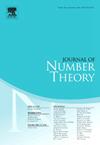关于二面波利亚场
IF 0.6
3区 数学
Q3 MATHEMATICS
引用次数: 0
摘要
当一个数域的整数环上的整值多项式模块具有规则基础时,该数域就是波利亚域。当一个四元场的分裂场的伽罗瓦群是由 8 个元素组成的二面群 D4 时,它就是一个 D4 场。本文证明,对于每个 ℓ∈{2,3,4,5} 都有ℓ 夯素数的 D4-Pólya 场有无穷多个,而具有 ℓ=1 夯素数的 D4 Pólya 场在 Q-isomorphism 下是 Q(1+2)、Q(-1+2) 或纯场。因此,我们回答了 [29] 提出的关于 D4 场的问题。同样的问题也出现在纯域上。我们找到了纯场的上限。对于小于这个上限的任何整数 ℓ,我们证明了有无穷多个具有 ℓ 夯素数的纯波利亚场,除了当 ℓ=1 时,我们证明了只有 2 个场(以及它们的两个共轭场)。本文章由计算机程序翻译,如有差异,请以英文原文为准。
On dihedral Pólya fields
A number field is a Pólya field when the module of integer-valued polynomials over its ring of integers has a regular basis. A quartic field is a -field when the Galois group of its splitting field is the dihedral group of 8 elements. In this paper, we prove that there are infinitely many -Pólya fields with ℓ ramified prime numbers for each and a Pólya field with ramified prime number, is, up to -isomorphism, , or a pure field. Consequently, we answer a question raised in [29] on -fields. The same question arises on pure fields. We find an upper bound for such fields. And for any integer ℓ less that this bound, we show that there are infinitely many pure Pólya fields with ℓ ramified prime numbers except when where we proved that there are only 2 fields (and their two conjugate fields)
求助全文
通过发布文献求助,成功后即可免费获取论文全文。
去求助
来源期刊

Journal of Number Theory
数学-数学
CiteScore
1.30
自引率
14.30%
发文量
122
审稿时长
16 weeks
期刊介绍:
The Journal of Number Theory (JNT) features selected research articles that represent the broad spectrum of interest in contemporary number theory and allied areas. A valuable resource for mathematicians, the journal provides an international forum for the publication of original research in this field.
The Journal of Number Theory is encouraging submissions of quality, long articles where most or all of the technical details are included. The journal now considers and welcomes also papers in Computational Number Theory.
Starting in May 2019, JNT will have a new format with 3 sections:
JNT Prime targets (possibly very long with complete proofs) high impact papers. Articles published in this section will be granted 1 year promotional open access.
JNT General Section is for shorter papers. We particularly encourage submission from junior researchers. Every attempt will be made to expedite the review process for such submissions.
Computational JNT . This section aims to provide a forum to disseminate contributions which make significant use of computer calculations to derive novel number theoretic results. There will be an online repository where supplementary codes and data can be stored.
 求助内容:
求助内容: 应助结果提醒方式:
应助结果提醒方式:


